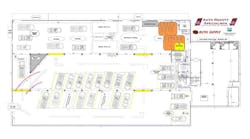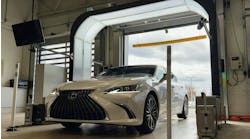Customer safety is always the primary focus for all decisions during a repair. Is the part, method, or material the safest for the customer? OEM procedures provide a road map to guide repairers to a predictable and safe result using new OEM parts. There are, however, challenges along the way. Some repairs are written with alternative parts.
Alternative parts serve a purpose. They provide options for consumers, increase competition, and allow for reuse of some parts to save on raw materials, energy, and landfill. Alternative parts, like aftermarket and used parts, are often specified on an insurer estimate. Insurers often figure used suspension to save on both parts and labor costs. But when it comes time to repair the vehicle, some additional considerations need to be made to determine if, in fact, the used suspension is the safe and cost-effective choice for the customer.
Used suspension requires some unique administrative work that new and aftermarket suspension do not. A quick perusing of salvage vendors online inventory pictures will quickly show there really isn’t a standard for selling used suspension. Pictures of donor cars will reveal massive structural damage at suspension mounts, direct wheel impacts on part being sold, and obvious damage to other suspension components on the same axle. If the customer’s safety is at the heart of the repair, used suspension must be given proper consideration. Whenever an estimate is quoted with used suspension there are five steps to take before ordering.
First, review the supplier’s inventory pictures of the donor vehicle. Analyze the hit that totaled the car and see if the part quoted could have been affected by the impact. There is a big difference between a car that was totaled from hail and one totaled by an impact. Remember to inspect the odometer picture as well.
If the pictures don’t raise safety concerns, the next step is to cross reference the donor car VIN and the customer’s VIN to confirm that the components have the same part number and options, and that no supersessions exist. Supersessions are a concern due to design improvements and compatibility with other components. Remember, it may not be possible to determine if the parts are the same simply through visual inspection and that salvage interchange is not always complete. If the part numbers and options codes check out, there are still three more inquiries to be made. Complete a check for any open recalls or service campaigns on the donor vehicle’s suspension.
Pending no incomplete recalls or campaigns, the fourth step is to identify prior losses before the donor car was ultimately salvaged. It is not uncommon for vehicles to have other repairs performed before a total loss event. This may require an insurer to run a prior claim query or for a repairer to utilize a third-party reporting site like Carfax to try to gain as much insight as possible into the donor car’s history.
Finally, if the vehicle’s loss history doesn’t raise any concerns, then asking the vendor for a copy of the alignment specs before dismantling should be the final and most granular aspect of the administrative research required to identify if the donor part is potentially viable for the customer’s repair.
At this point, there are some that will believe this level of research is excessive and unfair. Some will point out that no salvage supplier performs wheel alignments or has an alignment rack in the first place to satisfy this level of documentation. The real question to ask is, why not? You shouldn’t be expected to blindly trust a part just because it is available for sale on the internet. The important thing to remember is that none of this effort is required with new suspension and that the customer’s safety is paramount. This level of research takes time, and time is money, and none of it is included.
The considerations don’t stop with the initial analysis above. If a used suspension component is ordered, there are still additional considerations to make. First, the complete service history of the donor vehicle is still unknown and likely will never be known. How can you tell if a suspension component was previously replaced with another used or aftermarket component or even with the correct option part before the total loss event? How can you tell that all the fasteners were torqued properly or replaced if deemed one-time use by the OEM? Again, customer safety is paramount and to be safe, variables must be eliminated, which could result in complete overhaul of the used suspension and installation and proper torquing of all fasteners, including press in wheel studs. The risk is too great to blindly trust unknown fasteners.
Bolt stretch can be a concern if prior service procedures resulted in fasteners being improperly torqued and set up for potential future failure. There are additional labor considerations for removal of each un-needed component for a used suspension, such as speed sensors, brake hoses, rotors, pads, and other equipment. There are also labor considerations for transferring customer brake components and parking brake adjustments required after suspension replacement. And finally, shipping damage can occur to susceptible parts like backing plates and wheel studs during transport from a salvage vendor. Replacement of these components may require replacement of other sacrificial parts such as press-in hubs or bearings and is never included in used assembly labor times. All of these considerations increase the expense of utilizing used suspension further.
The considerations for used suspension don’t stop after installation. Even if an insurer quoted and a repairer properly installed a used suspension component there are considerations that carry on into the future. New parts and to some extent certified aftermarket parts have tracking mechanisms in place to affect a recall, if necessary. What mechanisms are in place to achieve the same result with a used suspension component that came from a vehicle with a different VIN? Remember, the part lives on after the install and so, too, must the customer.



